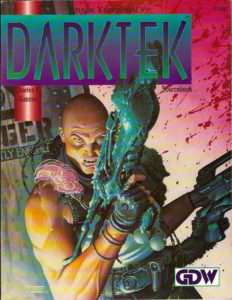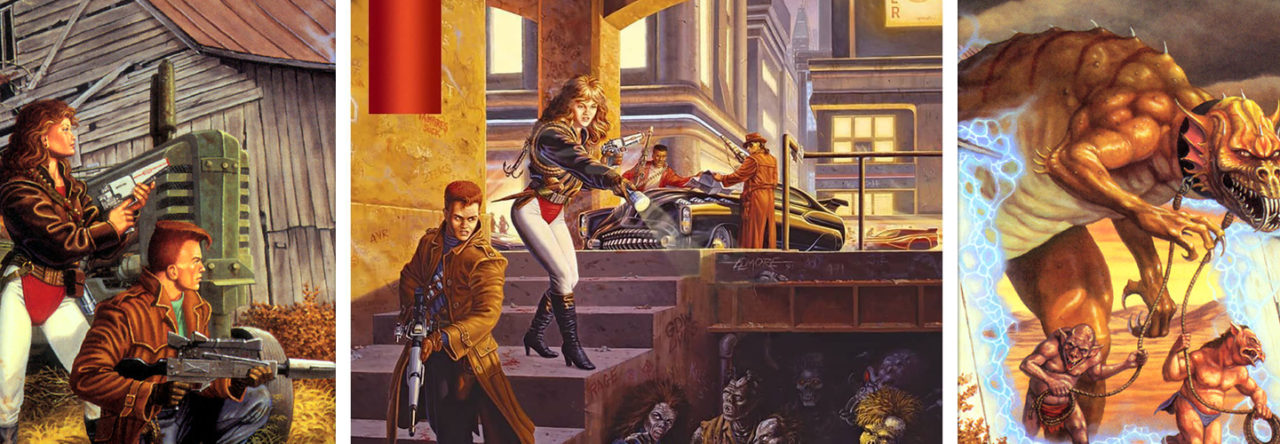Written by Charles E. Gannon (1991, GDW)
 The Darktek sourcebook is a bit of a departure for this site and its reviews; it is the first non-adventure (or campaign) that we have looked at. Weighing in at just over 100 pages, the Darktek sourcebook is a collection of devices, tools and weapons that are examples of the advances in technology that have come about since the arrival of the ET races and the Dark Minions.
The Darktek sourcebook is a bit of a departure for this site and its reviews; it is the first non-adventure (or campaign) that we have looked at. Weighing in at just over 100 pages, the Darktek sourcebook is a collection of devices, tools and weapons that are examples of the advances in technology that have come about since the arrival of the ET races and the Dark Minions.
Published by GDW in 1991 it was the second supplement to be published for the line and, while it did a lot to reinforce the retro-future feel to the game and its setting, it really felt more like an extension to the already impressive equipment section the Dark Conspiracy rulebook than a stand alone book. That said, while the book is firmly directed at Referees – it does include a number of neat and nasty secrets – the majority could easily be given to players to review and discuss.
Like every other GDW publication, Darktek is fully illustrated with pictures for pretty much every item described in the text. These range in quality from the typical black & white drawings through to, most impressively the full colour spreads (which are printed on glossy white paper) that illustrate scenes that come right of the sort of stories we expect from Dark Conspiracy.
One should also mention the fantastic colour cover of the book, a John Zeleznik classic. Depicting a soldier armed to the teeth with not only weapons – both human and ET – but also various pieces of Darktek, it represents, at least in my mind, everything this book could have been!
The Division of Labour
Darktek is divided into nine distinct chapters, two (Why Darktek? and The Nature of Darktek) focus on what Darktek is and how it can be used, and seven detailing the various categories of Darktek that could be encountered in play. These later chapters group together Darktek items based on their function and purpose, and range in subject from advanced biological devices to more common place consumer goods.
Why DarkTek?
This chapter introduces the reason why Dartek was written and just how this type of gear can be used available in the setting. Of course, knowing that this supplement comes from GDW (given the company’s interest in arms and equipment) it is unsurprising that a guide to Dark Conspiracy-specific equipment was created, but this chapter includes details on just how to get the most out of this type of technology in the game.
Sure, as the text highlights, all the gear from GDW’s other modern settings – MERC:2000 or Twilight:2000 – is fully compatible with Dark Conspiracy, but more than this, Darktek plays a role in the spirit of the game. I believe what the author is saying here is that simply giving players Darktek (more specifically ET and Darkling Darktek) isn’t the point. Rather it is how these items are revealed to the characters, and how they use them more important. Gaining access to an item of Darktek should be an adventure in of itself, and simply by acquiring such items indicates, on some level, just how entwined in the mysteries and conspiracies the Minion Hunters have become. Moreover, Darktek can be used as clues and leads as to what is really going on in the Referee’s scenarios and the world at large, acting as triggers that call the players into action as much as their characters. This in my opinion is the real purpose of this book and Darktek in general, to act as inspiration in play and indicators as to just how far players will go to right the wrongs 1.
The Nature of DarkTek
This chapter details the ‘mechanics’ of Darktek. As with all equipment in the setting, it introduces the cost and availability scale for each item listed, although it points out that almost all true Darktek devices can not be brought and are simply unavailable through normal means.
The core of this chapter, however, is the information around the effects and costs of using some forms of Darktek. This excellent addition to the game, one that highlights that the benefits of these items can comes at a cost. Darktek devices of this nature can have up to four ways in which can burden a Minion Hunter: Feed (the energy drained from the user to power an item); Control (how these items can make a Minion Hunter more susceptible to Darkling powers); Detection (some devices act as beacons to the Dark Ones), and Recharge (the electrical energy needed to run the device, be it from conventional means or from a users own life force). Of course not all Darktek items have all of these requirements, and in fact many have no ill effects from use at all, but those that do are likely to be a double-edged sword to any one wanting to possess these powerful devices.
The chapter rounds out with a note on how one can rid themselves of an item of Darktek. Again, most devices are easy disposed of, but in some cases, especially those which have a feed requirement, Darktek must be surgically removed from its host. Once more this is an excellent example of how Dark Conspiracy can be creepy and disturbing.
Darktek Devices
The remainder of the book focuses on a selection of Darktek, and for simplicity sake the following summarises each of the remaining chapters.
- Biological Devices – As can be surmised from the title, this chapter focuses on items of a biological nature. Interestingly all of the Darktek listed here is of Dark Minion origin, but when reading more on the game altering effects of these chemicals and viruses, it is of little surprise this is the case. A number of these items focus on the Empathic abilities of either humans or Darklings, while most others involve trying to control or enhance their target. I think that this is actually the best section for the devices, and definitely one of the creepiest.
- Electronic Devices – These mostly Human or Humaniod ET devices posit the possible advances in electronics and computers in future of Dark Conspiracy. Unfortunately, given the 20-plus years since the release of this book, most if not all of these tools seem antiquated and overly clunky in concept. Beyond that however, this chapter offers very little in the way of actual Darktek and nothing that a good Referee couldn’t create themselves in play.
- Weapons – If guns are your thing in DC then this is the chapter for you. Here you find interesting Darkling and ET weapons, such as the Bolter and Spectral Gatherer, as well as more mundane human weapons (which seem every out of place in a Darktek book – Spear Gun? Saw-Off Shotgun?). The chapter also introduces a couple of new types of armour that will quickly become standard equipment for most Minion Hunters.
- Vehicles – An eclectic collection of new cars, planes and ‘devices’ is provided next. Again this chapter includes too many non-Darktek descriptions for my liking (especially in respects to the cars), but makes up for this in some ways with the introduction of darkling devices like the Folder Pod and Spaceswimmer, both of which extremely useful although eerily disgusting to visualise in use.
- Robots – It is interesting to see a focus on robots in the book, as the advances in this type of technology always defines much on in the setting, in my opinion. This chapter covers a range of robot types, from androids through to remotely controlled drones, and includes examples of everything from babysitters to war machines. The only unfortunate thing about the devices presented here, is that once more the majority are man-made, rather than emanating from the Darklords.
- Miscellaneous Equipment – This is an interest chapter and focuses quite heavily on various safety and life support devices that have become available in the age of Dark Conspiracy. These are definitely a ‘grab-bag’ of tools and items, and while that are likely he most helpful devices for Minion Hunters will likely be quickly overlooked by those wanting real Darktek..
- Consumer Goods – It seems inevitable that the influence of Dartek would filter through into the consumer sphere. By far the briefest chapter (only 2 full pages), it covers a small range of items that I think would rarely be of interest to Minion Hunters. In fact the whole chapter seems to have simply been thrown in at the end of the book as some sort of filler; even its chapter header art – a woman witnessing a giant spider attack on a school bus – just looks out of place.
Conclusions
What can one say about Darktek? I have to be up front and say that I feel that this book was a missed opportunity for Dark Conspiracy, and much of what was provided seems to have been included without much thought. Now, I don’t say that only because much of the ‘advanced’ technology is antiquated in today’s terms, but rather, in my opinion, it includes way too much equipment and technology that is of normal human origin. I firmly believe that DarkTek should have been a book that Referees and players would have literally died for to have on their shelves, but in the end – after a fantastic start with the diverse and creepy biological devices – feels more like an uncontrolled wander through the author’s wish list of ‘stuff’ missing from the rulebook.
What makes this worse is the excellent premise raised in the first couple of chapters – using Darktek as setting tools and motivators, not to mention the inclusion of the various drawbacks to using this type of technology2 – is never fully realised. This is a real shame, and for me at least relegates the book to be little more than a few extra toys for the players or a place to draw a little inspiration when creating my own DC adventures.
Now there are some really good aspects to this book outside the devices themselves, two-page spread colour art is inspirational, and pictures such as those on pages 18-19 and 86-87 a begging for their stories to be told. And even amongst the Darktek there are a number of real gems that could be the focus of whole campaigns let alone adventures. But as I said, there is just too much ‘chaff’ to make the entire book worthwhile.
In summary, while I really do think that there is a place for a Darktek book in Dark Conspiracy setting, it is a disappointment that this is not it.
Darktek, 1991 GDW (GDW 2102) – ISBN 1-55878-084-X
Design: Charles E. Gannon
Development: Lester W. Smith
Art Direction: Amy Doubet
Graphic Design and Production: LaMont Fullerton & KirkWescom
Interior Art: Steve Bryant, Paul Daly, Elizabeth T. Danforth, Lamont Fullerton, Rick Harris, David Martin, Ellisa Martin, & David O. Miller
Interior Color: Grant Goleash
Cover Art: John Zeleznik
Typesetting: Stephen Olle
Proofreading: Stephen Olle & Michelle Sturgeon
Text Processing: Sarah Knecht & Steve Maggi

